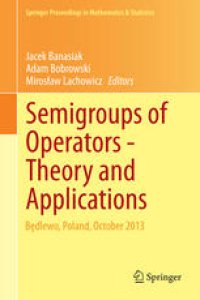
Ebook: Semigroups of Operators -Theory and Applications: Będlewo, Poland, October 2013
- Tags: Operator Theory, Probability Theory and Stochastic Processes, Mathematical Applications in the Physical Sciences, Ordinary Differential Equations, Functional Analysis, Integral Equations
- Series: Springer Proceedings in Mathematics & Statistics 113
- Year: 2015
- Publisher: Springer International Publishing
- Edition: 1
- Language: English
- pdf
Many results, both from semi group theory itself and from the applied sciences, are phrased in discipline-specific languages and hence are hardly known to a broader community. This volume contains a selection of lectures presented at a conference that was organised as a forum for all mathematicians using semi group theory to learn what is happening outside their own field of research. The collection will help to establish a number of new links between various sub-disciplines of semigroup theory, stochastic processes, differential equations and the applied fields.
The theory of semigroups of operators is a well-developed branch of functional analysis. Its foundations were laid at the beginning of the 20th century, while the fundamental generation theorem of Hille and Yosida dates back to the forties. The theory was, from the very beginning, designed as a universal language for partial differential equations and stochastic processes, but at the same time it started to live as an independent branch of operator theory. Nowadays, it still has the same distinctive flavour: it develops rapidly by posing new ‘internal’ questions and in answering them, discovering new methods that can be used in applications. On the other hand, it is influenced by questions from PDEs and stochastic processes as well as from applied sciences such as mathematical biology and optimal control, and thus it continually gathers a new momentum. Researchers and postgraduate students working in operator theory, partial differential equations, probability and stochastic processes, analytical methods in biology and other natural sciences, optimization and optimal control will find this volume useful.
Many results, both from semigroup theory itself and from the applied sciences, are phrased in discipline-specific languages and hence are hardly known to a broader community. This volume contains a selection of lectures presented at a conference that was organised as a forum for all mathematicians using semigroup theory to learn what is happening outside their own field of research. The collection will help to establish a number of new links between various sub-disciplines of semigroup theory, stochastic processes, differential equations and the applied fields.
The theory of semigroups of operators is a well-developed branch of functional analysis. Its foundations were laid at the beginning of the 20th century, while the fundamental generation theorem of Hille and Yosida dates back to the forties. The theory was, from the very beginning, designed as a universal language for partial differential equations and stochastic processes, but at the same time it started to live as an independent branch of operator theory. Nowadays, it still has the same distinctive flavour: it develops rapidly by posing new ‘internal’ questions and, in answering them, discovering new methods that can be used in applications. On the other hand, it is influenced by questions from PDEs and stochastic processes as well as from applied sciences such as mathematical biology and optimal control, and thus it continually gathers a new momentum. Researchers and postgraduate students working in operator theory, partial differential equations, probability and stochastic processes, analytical methods in biology and other natural sciences, optimization and optimal control will find this volume useful.